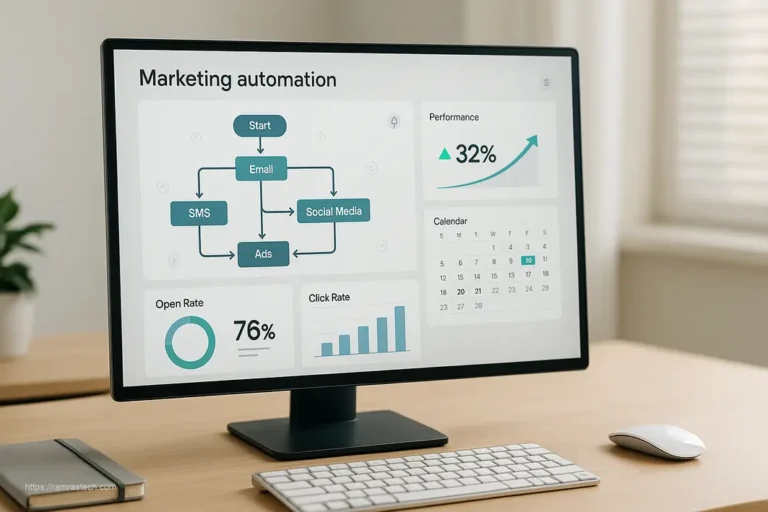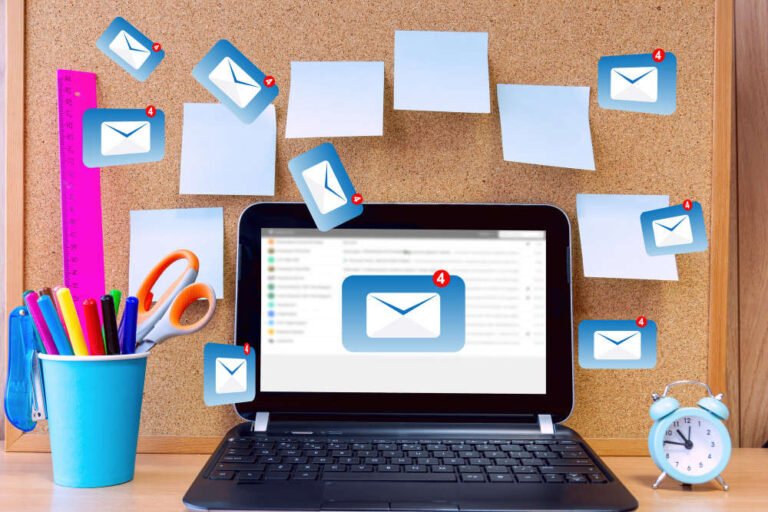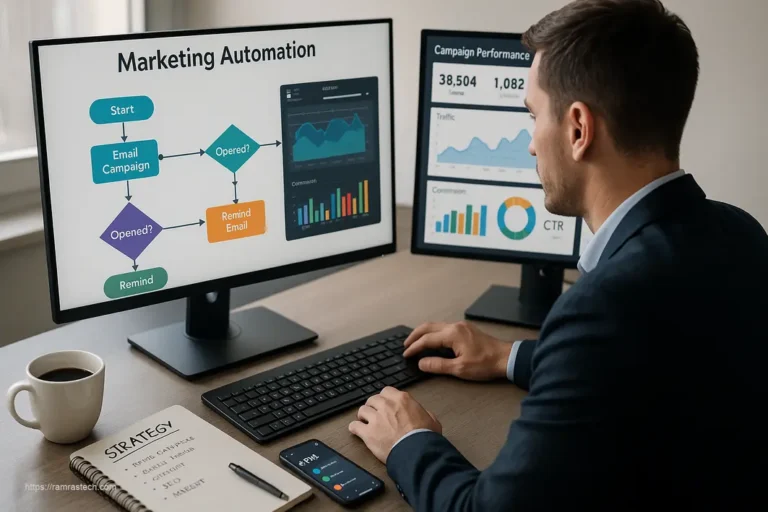Ultimate Guide to Affordable Marketing Automation for SMEs

Let’s face it – as small business owners, we’re constantly juggling a million tasks while trying to grow our companies on tight budgets. Sound familiar? I remember when my marketing consisted of manually sending emails, posting on social media whenever I remembered, and hoping something would stick. It was exhausting, inefficient, and frankly, not very effective.
But here’s the good news: affordable marketing automation has completely transformed how small businesses operate. You no longer need the resources of a Fortune 500 company to implement sophisticated marketing strategies that convert leads and build lasting customer relationships.
What Exactly Is Marketing Automation (And Why Should Small Businesses Care)?
Marketing automation uses software to automate repetitive marketing tasks and workflows. Instead of manually sending follow-up emails, scheduling social posts, or qualifying leads, these systems handle it automatically based on triggers you set up.
For small businesses, this is game-changing. With limited staff and resources, automation allows you to punch above your weight class without burning out your team or breaking the bank.
As Dana Wilson, founder of a growing e-commerce startup, told me: “Marketing automation saved my business. We were spending 20+ hours weekly on manual marketing tasks. Now those run in the background while we focus on strategy and growth.”
The Cost-Benefit Reality of Marketing Automation for Small Businesses
Let’s address the elephant in the room. Yes, marketing automation requires an investment. But the return on that investment is where things get interesting.
According to research from Nucleus Research, marketing automation drives a 14.5% increase in sales productivity and a 12.2% reduction in marketing overhead. Think about it – what could your business accomplish if you could reduce marketing costs while simultaneously increasing results?
The truth is, NOT implementing affordable marketing automation is likely costing you more in wasted time, missed opportunities, and inefficient processes.
7 Powerful Benefits of Affordable Marketing Automation
1. Reclaim Your Most Valuable Resource: Time
Time might be your scarcest resource as a small business owner. Marketing automation systems handle repetitive tasks like email scheduling, social media posts, and lead scoring, allowing you and your team to focus on growth strategies rather than mundane marketing tasks.
A study by Salesforce found that marketing automation users reported saving 15+ hours per week that were previously spent on manual tasks. Imagine what your business could accomplish with an extra 60 hours of strategic work each month!
2. Generate and Nurture Leads While You Sleep
Leads are the lifeblood of any business, but the traditional approach of manually following up with each prospect is unsustainable for small teams.
Marketing automation enables you to communicate with leads based on specific criteria rather than manual selection. This targeted approach puts an end to less effective marketing efforts like cold calling based on single touchpoints. Companies using platforms like Salesforce for marketing automation have reported a 30% growth in lead conversion rates, making this one of the most valuable benefits for growth-focused small businesses.
One small real estate firm implemented an automated lead nurturing campaign that continued engaging prospects for 14 months – eventually closing deals with leads who would have been long forgotten in a manual system.
3. Create Personalized Customer Journeys Without The Complexity
The days of one-size-fits-all marketing are over. Today’s consumers expect personalized experiences, but delivering this level of customization manually is virtually impossible for small teams.
With marketing automation, you can segment your audience based on their behaviors, preferences, and demographics, then deliver targeted content that resonates with each group. Personalized emails deliver six times higher transaction rates compared to generic communications, according to research from Experian.
One local boutique I worked with used simple automation to send personalized product recommendations based on previous purchases. The result? A 34% increase in repeat customer sales within three months.
4. Make Data-Driven Decisions (Even Without a Data Analyst)
One of the most overlooked benefits of marketing automation is its ability to provide actionable insights without needing a dedicated analytics team.
Modern automation platforms track customer interactions across multiple channels and consolidate this data into understandable reports. You can see what’s working, what isn’t, and adjust your strategy accordingly.
A small consulting firm used their automation platform’s analytics to discover their Tuesday afternoon emails had 3x higher engagement than their Friday morning sends – a simple insight that boosted their results immediately.
5. Achieve Consistency That Builds Trust
Consistent marketing is effective marketing. Yet consistency is exactly what suffers when you’re manually managing your marketing efforts.
Automation ensures your marketing messages go out on schedule, maintain consistent branding, and deliver a reliable experience that builds credibility with your audience. Your newsletters arrive when expected, your social channels remain active, and your follow-ups never fall through the cracks.
“Before automation, our marketing was feast or famine,” explains James Chen, owner of a small accounting firm. “We’d blitz our channels when we had time, then go silent during busy periods. Our engagement suffered tremendously. Automation has given us the consistency our brand needed.”
6. Scale Your Marketing Efforts Without Scaling Your Team
How do you grow your marketing impact without expanding your team? Automation provides the answer.
As your business grows, your automation systems can easily accommodate more contacts, more complex campaigns, and more touchpoints without requiring proportional increases in staff or hours worked.
A small e-learning company grew from 500 to 10,000 subscribers in 18 months without hiring additional marketing staff. Their automation system scaled effortlessly, continuing to nurture leads and convert customers despite a 20x increase in audience size.
7. Improve Cash Flow With Predictable Marketing Costs
Few things stress small business owners more than unpredictable expenses. Traditional marketing often comes with variable costs that fluctuate month to month.
Most marketing automation platforms operate on subscription models with fixed monthly costs, making budgeting more predictable. This predictability helps improve cash flow management – a critical factor for small business sustainability.
Affordable Marketing Automation Tools That Won’t Break The Bank
Now let’s talk specifics – which tools provide the best value for small businesses with limited budgets?
Email Marketing Automation
MailerLite – Starting at just $10/month, MailerLite offers impressive automation capabilities including triggered emails, segmentation, and A/B testing. Their user-friendly interface makes it accessible even for beginners.
Sendinblue – With plans starting at $25/month, Sendinblue combines email marketing, SMS marketing, and chat functionality with robust automation workflows. Their free tier includes up to 300 emails per day – perfect for very small businesses just getting started.
Moosend – Starting at $9/month, Moosend offers powerful automation workflows, list segmentation, and personalization features at a price point small businesses can afford.
Social Media Automation
Buffer – For as little as $15/month, Buffer allows you to schedule posts across multiple platforms, analyze performance, and maintain a consistent social presence without daily manual work.
SocialBee – Starting at $19/month, SocialBee offers content categorization, recycling evergreen posts, and social media calendar management that punches above its price point.
All-in-One Marketing Platforms
ActiveCampaign – Starting around $29/month, ActiveCampaign offers email marketing, CRM, messaging, and robust automation capabilities that grow with your business.
HubSpot – While their full suite is enterprise-level, HubSpot offers free and affordable starter plans that give small businesses access to professional-grade automation tools.
GetResponse – Starting at $15/month, GetResponse offers email marketing, landing pages, and surprisingly robust automation workflows that integrate multiple marketing functions.
Lead Generation & Capture Automation
ConvertBox – A one-time payment option (currently $395 for lifetime access) makes this intelligent lead capture tool affordable for businesses looking to avoid subscription fatigue.
Leadpages – Starting at $27/month, Leadpages helps small businesses automatically capture and process leads through landing pages and pop-ups.
How To Implement Affordable Marketing Automation (Without Getting Overwhelmed)
Many small business owners get excited about automation but then freeze when faced with actually implementing it. Here’s a step-by-step approach that makes the process manageable:
1. Start With Your Biggest Pain Point
Resist the urge to automate everything at once. Instead, identify your most time-consuming marketing task or biggest missed opportunity. Is it follow-up emails? Lead qualification? Social media consistency? Start there.
2. Choose Tools That Play Well Together
Before committing to any platform, verify it integrates with your existing systems. The best automation still requires manual work if you have to transfer data between unconnected platforms.
3. Create Simple Workflows Before Complex Ones
Begin with basic automation sequences – like a welcome email series for new subscribers or abandoned cart reminders. Master these fundamentals before moving to more sophisticated multi-channel campaigns.
4. Test Before Full Deployment
Send test emails to yourself and colleagues. Run automation workflows with a small segment of your audience first. Look for any glitches or awkward messaging before rolling out to your entire customer base.
As Julie Martinez, owner of a boutique marketing agency, advises: “We always test automations with internal email addresses for at least a week before activating them for clients. We’ve caught countless small issues that could have become big embarrassments.”
5. Monitor, Measure, and Optimize
Automation isn’t a “set it and forget it” solution. Schedule regular reviews of your automated workflows to ensure they’re performing as expected. Look for opportunities to improve open rates, click-throughs, and conversions.
Avoiding Common Automation Pitfalls
As someone who’s helped dozens of small businesses implement marketing automation, I’ve seen the same mistakes repeatedly. Here’s how to avoid them:
Over-Automation
Not everything should be automated. High-touch points in the customer journey often benefit from a human approach. Identify where the personal touch matters most to your customers and preserve it.
Poor Segmentation
Sending the same automated messages to your entire audience undermines the personalizing power of automation. Take time to create meaningful segments based on customer behavior, preferences, and needs.
Neglecting the Human Voice
Automated messages should still sound like they come from a real person. Review your automation sequences regularly to ensure they maintain your brand’s authentic voice and don’t sound robotic.
Failing to Update Content
Outdated offers, old product information, or references to past events in automated sequences damage your credibility. Schedule quarterly reviews of all automation content to keep it fresh and accurate.
Real-World Success: Small Businesses Winning With Affordable Automation
Let’s look at some inspiring examples of small businesses leveraging affordable marketing automation to achieve impressive results:
Local Fitness Studio Increases Membership Retention by 32%
A small fitness studio with just two full-time employees implemented an automated member engagement sequence that delivered personalized workout suggestions, check-in reminders, and milestone celebrations. Their membership retention increased by 32% within six months, while administrative work decreased by approximately 15 hours weekly.
E-Commerce Startup Recovers 21% of Abandoned Carts
An artisanal foods e-commerce company set up a three-part abandoned cart automation sequence that gently reminded shoppers of items left behind. This simple automation recovered 21% of otherwise lost sales – a significant revenue boost that required zero ongoing manual effort.
Service Business Reduces No-Shows by 67%
A small home services company implemented automated appointment reminders via email and SMS. Their no-show rate dropped from 12% to just 4%, resulting in recovered revenue and improved scheduling efficiency.
Measuring Your Automation ROI
How do you know if your investment in marketing automation is paying off? Focus on these key metrics:
- Time Saved – Track hours recovered from manual marketing tasks
- Lead Conversion Rate – Monitor improvements in prospect-to-customer conversion
- Customer Retention – Measure increases in repeat business and customer lifetime value
- Revenue Growth – Calculate additional revenue attributable to automated campaigns
- Marketing Efficiency – Compare marketing costs as a percentage of revenue before and after automation
Frequently Asked Questions About Affordable Marketing Automation
How much should a small business invest in marketing automation?
Most small businesses should start with $50-200 per month for automation tools. This investment typically delivers a positive ROI within 3-6 months through time savings and improved conversion rates. Begin with tools that address your most pressing needs, then expand as you see results.
Can marketing automation work for service-based businesses?
Absolutely! Service businesses often see tremendous benefits from automating appointment reminders, client onboarding, satisfaction follow-ups, and review requests. A consultant I worked with automated her client check-ins and testimonial requests, saving 7+ hours weekly while increasing her review collection by 340%.
How long does it take to set up marketing automation?
Basic email sequences can be set up in a few hours. More complex multi-channel campaigns might take several days to configure properly. The key is starting small with immediate pain points, then gradually expanding your automation ecosystem as you build confidence.
Will automation make my marketing feel impersonal?
Poorly implemented automation can indeed feel robotic. However, well-designed automation actually enables greater personalization by delivering the right message to the right person at the right time – something impossible to achieve manually at scale. The key is maintaining your authentic voice and using customer data to create truly relevant experiences.
How often should I update my automation sequences?
At minimum, review all automation content quarterly. Additionally, check performance metrics monthly to identify any sequences that might need optimization due to declining engagement rates.
Taking The Next Step With Affordable Marketing Automation
Marketing automation isn’t just for big companies with big budgets anymore. Today’s affordable tools put sophisticated marketing capabilities within reach of even the smallest businesses.
Start small, focus on solving specific problems, and measure your results. You’ll likely find that automation not only saves time but also improves your marketing effectiveness in ways manual processes simply can’t match.
Remember that automation should enhance your human connection with customers, not replace it. The most successful small businesses use automation to handle repetitive tasks while freeing up their team to focus on creative strategy and meaningful customer interactions.
Top 5 Email Marketing Tools for Small Businesses can help you find the right platform to begin your automation journey. And if you’re looking to maximize your overall marketing impact, check out our guide on Affordable Digital Marketing: Maximizing Your Budget.
The future belongs to small businesses that can leverage technology to compete with larger players. Affordable marketing automation isn’t just a nice-to-have anymore—it’s becoming essential for sustainable growth in today’s competitive landscape.






